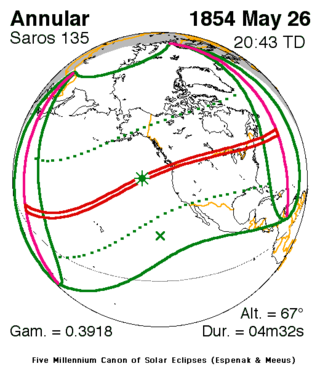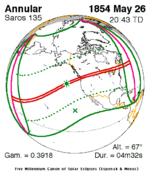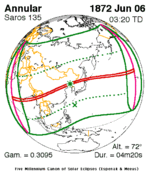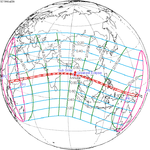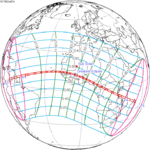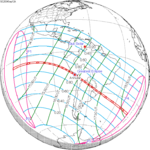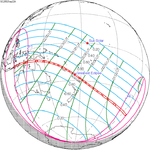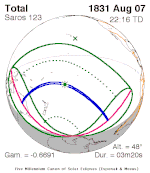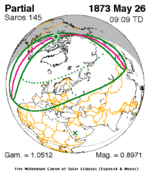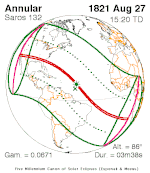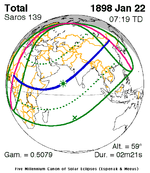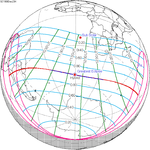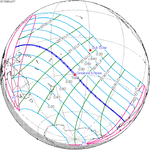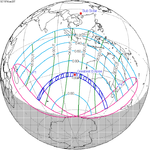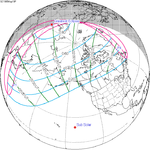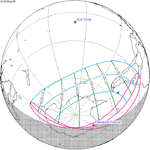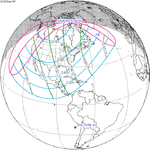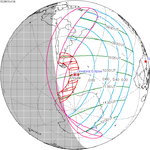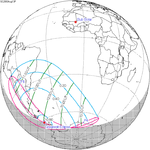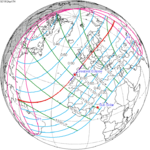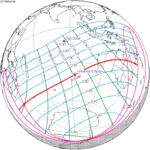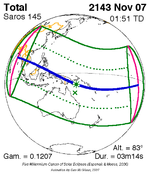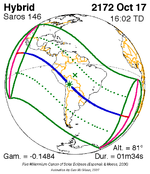|
Solar eclipse of May 26, 1854
An annular solar eclipse occurred at the Moon's ascending node of orbit on Friday, May 26, 1854, with a magnitude of 0.9551. A solar eclipse occurs when the Moon passes between Earth and the Sun, thereby totally or partly obscuring the image of the Sun for a viewer on Earth. An annular solar eclipse occurs when the Moon's apparent diameter is smaller than the Sun's, blocking most of the Sun's light and causing the Sun to look like an annulus (ring). An annular eclipse appears as a partial eclipse over a region of the Earth thousands of kilometres wide. Occurring about 3.2 days before apogee (on May 30, 1854, at 2:25 UTC), the Moon's apparent diameter was smaller.[1] The path of annularity was visible from parts of the modern-day Marshall Islands, southern Canada, Washington, northern Idaho, northern Montana, northern North Dakota, Minnesota, the upper peninsula of Michigan, New York, Vermont, New Hampshire, Massachusetts, and Maine. A partial solar eclipse was also visible for parts of Northeast Asia, northern Oceania, Hawaii, North America, Central America, the Caribbean, far northern South America, and northern Scandinavia. VisibilityThe annular path crossed close to the boundary between the United States and Canada. Observations
Eclipse detailsShown below are two tables displaying details about this particular solar eclipse. The first table outlines times at which the moon's penumbra or umbra attains the specific parameter, and the second table describes various other parameters pertaining to this eclipse.[2]
Eclipse seasonThis eclipse is part of an eclipse season, a period, roughly every six months, when eclipses occur. Only two (or occasionally three) eclipse seasons occur each year, and each season lasts about 35 days and repeats just short of six months (173 days) later; thus two full eclipse seasons always occur each year. Either two or three eclipses happen each eclipse season. In the sequence below, each eclipse is separated by a fortnight.
Related eclipsesEclipses in 1854
Metonic
Tzolkinex
Half-Saros
Tritos
Solar Saros 135
Inex
Triad
Solar eclipses of 1852–1855This eclipse is a member of a semester series. An eclipse in a semester series of solar eclipses repeats approximately every 177 days and 4 hours (a semester) at alternating nodes of the Moon's orbit.[3] The partial solar eclipse on January 21, 1852 occurs in the previous lunar year eclipse set.
Saros 135This eclipse is a part of Saros series 135, repeating every 18 years, 11 days, and containing 71 events. The series started with a partial solar eclipse on July 5, 1331. It contains annular eclipses from October 21, 1511 through February 24, 2305; hybrid eclipses on March 8, 2323 and March 18, 2341; and total eclipses from March 29, 2359 through May 22, 2449. The series ends at member 71 as a partial eclipse on August 17, 2593. Its eclipses are tabulated in three columns; every third eclipse in the same column is one exeligmos apart, so they all cast shadows over approximately the same parts of the Earth. The longest duration of annularity was produced by member 16 at 10 minutes, 41 seconds on December 24, 1601, and the longest duration of totality will be produced by member 62 at 2 minutes, 27 seconds on May 12, 2431. All eclipses in this series occur at the Moon’s ascending node of orbit.[4]
Metonic seriesThe metonic series repeats eclipses every 19 years (6939.69 days), lasting about 5 cycles. Eclipses occur in nearly the same calendar date. In addition, the octon subseries repeats 1/5 of that or every 3.8 years (1387.94 days). All eclipses in this table occur at the Moon's ascending node.
Tritos seriesThis eclipse is a part of a tritos cycle, repeating at alternating nodes every 135 synodic months (≈ 3986.63 days, or 11 years minus 1 month). Their appearance and longitude are irregular due to a lack of synchronization with the anomalistic month (period of perigee), but groupings of 3 tritos cycles (≈ 33 years minus 3 months) come close (≈ 434.044 anomalistic months), so eclipses are similar in these groupings. The partial solar eclipses on December 7, 2170 (part of Saros 164) and November 7, 2181 (part of Saros 165) are also a part of this series but are not included in the table below.
Inex seriesThis eclipse is a part of the long period inex cycle, repeating at alternating nodes, every 358 synodic months (≈ 10,571.95 days, or 29 years minus 20 days). Their appearance and longitude are irregular due to a lack of synchronization with the anomalistic month (period of perigee). However, groupings of 3 inex cycles (≈ 87 years minus 2 months) comes close (≈ 1,151.02 anomalistic months), so eclipses are similar in these groupings.
Notes
References
Wikimedia Commons has media related to Solar eclipse of 1854 May 26 in the United States. |
||||||||||||||||||||||||||||||||||||||||||||||||||||||||||||||||||||||||||||||||||||||||||||||||||||||||||||||||||||||||||||||||||||||||||||||||||||||||||||||||||||||||||||||||||||||||||||||||||||||||||||||||||||||||||||||||||||||||||||||||||||||||||||||||||||||||||||||||||||||||||||||||||||||
